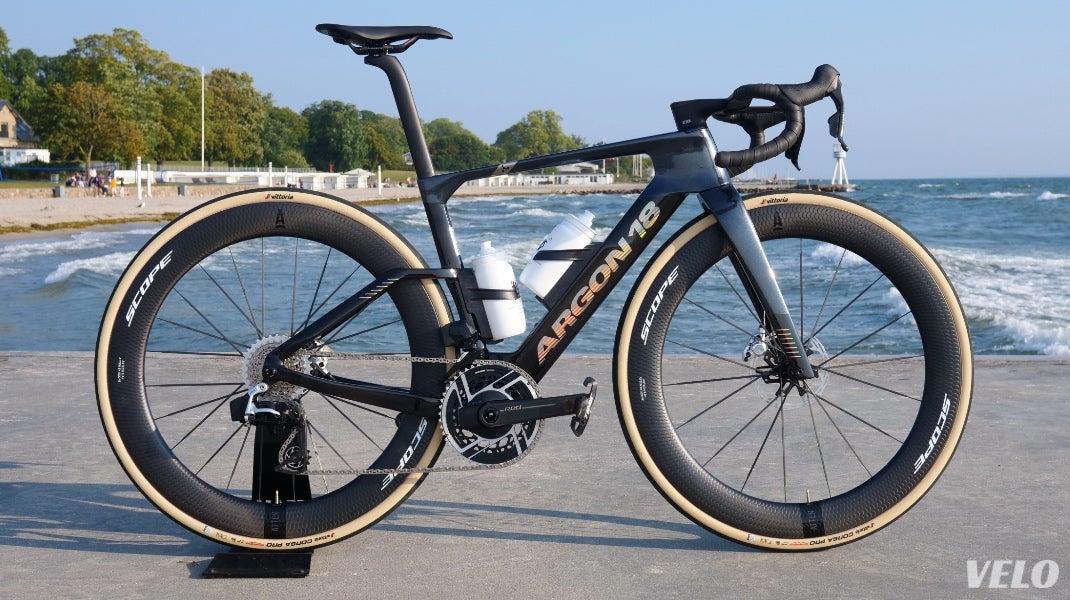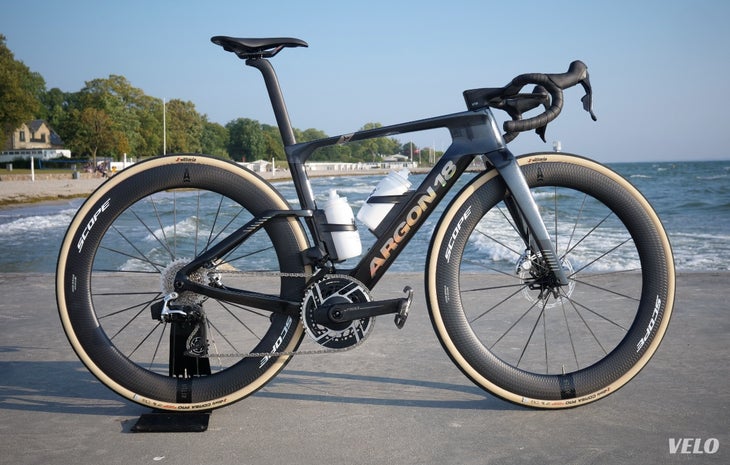 Argon 18’s new Nitrogen. Fast and light, can you have it all?
Argon 18’s new Nitrogen. Fast and light, can you have it all?
In the past 12 years of this job, I can pretty much count on one hand the bikes that have seriously excited me: BMC’s lively lightweight rim braked TeamMachine SLR01 I tested back in about 2017; Ritchey’s calming Road Logic; Cervelo’s original S5 that felt like it wanted to roll all day; and more recently Orbea’s new Terra race, a gravel bike that wants to be thrown about. And for the second time in 2025, another bike joins the list, Argon 18’s new Nitrogen. All these bikes had a character to them that, if I had the money (and garage space), I’d love to add to my fleet.
But first, before we get to that review, let’s delve into some details on the new 2026 Nitrogen.
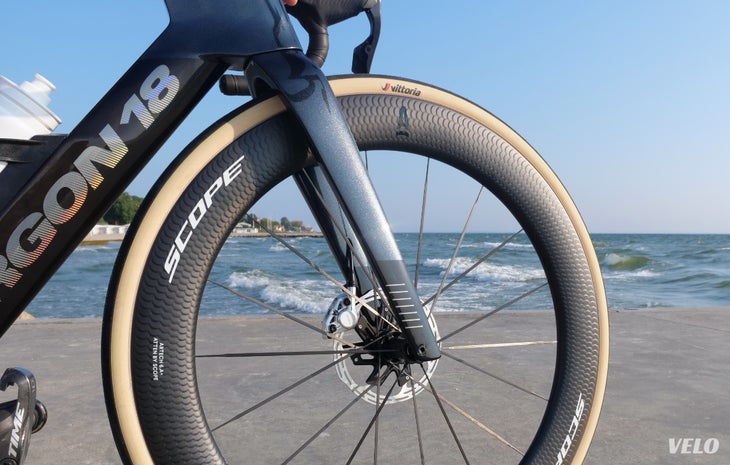 It’s not just the frame and bars that the engineers have worked on; they’ve included working with Scope on developing a specific wheel for the bike.
It’s not just the frame and bars that the engineers have worked on; they’ve included working with Scope on developing a specific wheel for the bike.
The details
The Nitrogen, as mentioned, is Argon 18’s aero optimized road bike. When compared to their all-around race bike in their range, the Sum Pro, the Nitrogen is claimed to be 24 watts faster at 45kmh. To achieve these differences, the engineers behind the bike have focsued not just on the usual frame details, taking into account the latest updates of the UCI rules, but also on what is now becoming a bit more standard: looking at the bike as a complete package. But they’ve taken it a step further by also also delving into examining how wheel and tire combinations could aid in achieving a slippery frame. To do this, they partnered with Scope to help produce a specific wheel set designed and only available with the Nitrogen.
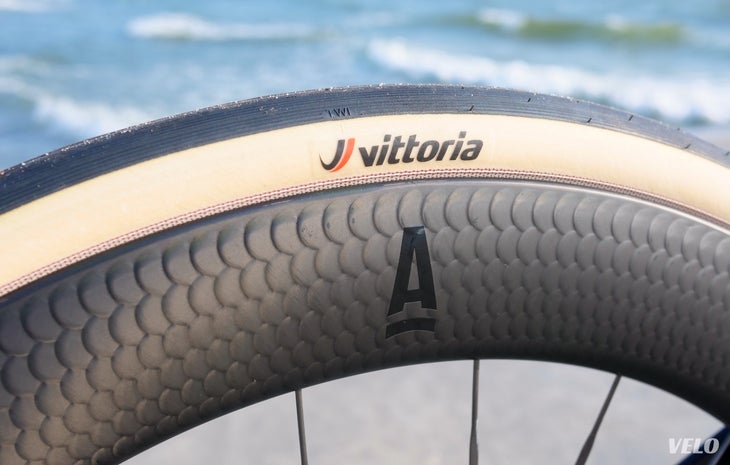 The Attn wheelset is 1.3mm wider than the standard Scope version, and designed to work alongside Vittoria Corsa 30mm tires.
The Attn wheelset is 1.3mm wider than the standard Scope version, and designed to work alongside Vittoria Corsa 30mm tires.
The wheelset in question is a tweaked version of Scopes’ “Scaly” Artech 6. Argon 18’s version of this wheelset comes under the new “parts” brand, Atten (18 in Dutch). The difference between the standard Artech 6 and the Atten Artech6+ is that externally, they are 1.3mm wider than the standard version. The updated design is claimed to improve airflow, but only when combined with their preferred 30mm Vittoria Corsa Pro tubulars. So, yes, if you want the best performance out of this bike, you need to stick with the Corsa Pro tires. Not too much of an issue in my eyes, as it’s a pretty delightful tire to use. Expensive, yes, but great performing.
Weight-wise, it’s not your usual aero bike, with the frame coming in at a slender 950g, only 100g more than the Sum Pro. Builds can get down to as little as a claimed 6.95kg, although on display in the Argon 18 HQ was a medium Nitrogen at a whispy 6.5kg, albeit with a raw carbon finish.
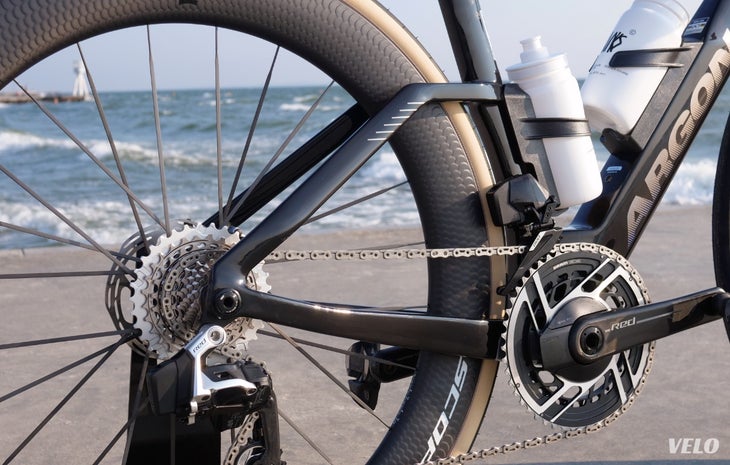 Horizontal dropped stays, a carryover from Argon 18’s track bikes.
Horizontal dropped stays, a carryover from Argon 18’s track bikes.
Frame design is what you’d expect from a modern aero frame, taking all the cues from what the current UCI rules allow. Deep head tube and down tubes, a massive bottom bracket area that is claimed to be 18.5% stiffer than the Sum Pro, though just as comfortable. And then there are the excessively low dropped stays that certainly hint of design flourishes taken from their popular track bike. Other notable updates include proprietary bottle cages, which, unlike some other brands’ bikes, accept standard bottles.
Bars come under their Atten range too, in this case, the one-piece Atten CHB-01 Aero Handlebar. With a three-degree inward flair at the hoods, allowing the levers to have a natural inward tilt and a more aerodynamic position, this, mixed with a slight arrowing and narrow central front section, makes for a comfortable position. More on that in the video.
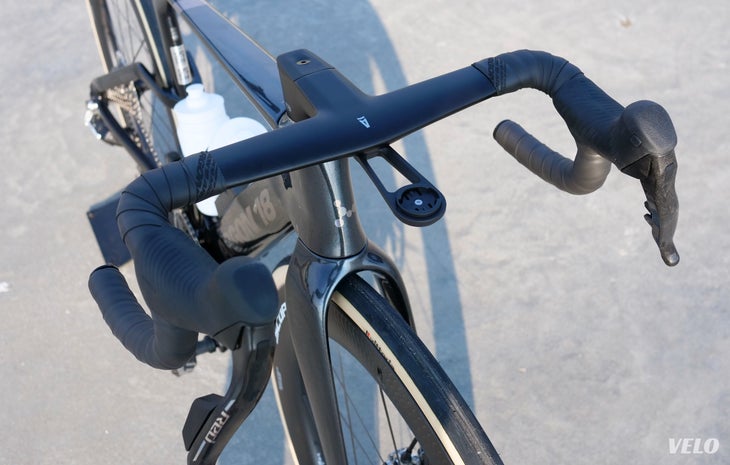 I usually dislike narrow bars; the Attn cockpit was a pleasant surprise.
I usually dislike narrow bars; the Attn cockpit was a pleasant surprise.
Elsewhere, the model I rode came with a Repente Quasar CR saddle and the SRAM Red AXS groupset. The Nitrogen also comes installed with a CeramicSpeed bottom bracket and CeramicSpeed SLT headset bearing.
If your budget can accommodate the high asking price, there is also a non-Pro Nitrogen, the Elite option, available. The frameset uses a less premium carbon, producing what they claim are the same ride characteristics but with a weight penalty of 200g. It, though, doesn’t come with the Atten 6.A+ wheels, ceramic bearings, and bottom bracket.
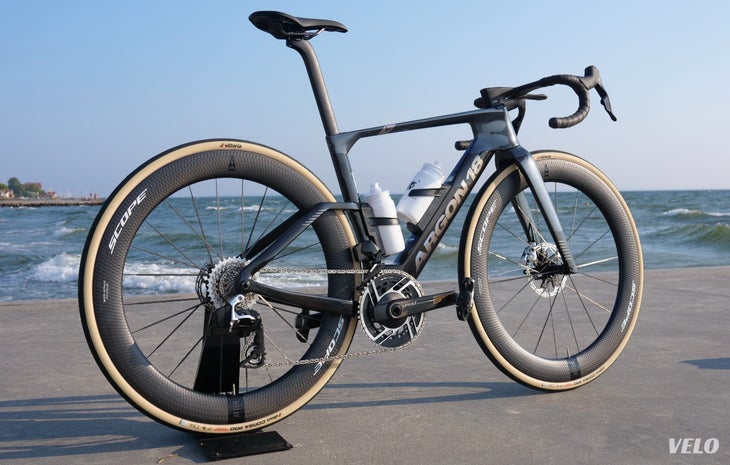 The top-end build with SRAM Red AXS isn’t cheap. But that goes for many, many bikes today.
The top-end build with SRAM Red AXS isn’t cheap. But that goes for many, many bikes today.
Prices
Nitrogen Pro, including the Atten/Scope wheels, will be available in a single color option and be offered in three builds.
Dura-Ace: $13,000 / £12,500 / €13,495
Ultegra build : $9,800 / £9,500 / €10,995
Red AXS: $13,500 / £13,000 / €13,995
The Nitrogen Elite will also be available in two colors, a fetching satin silver and a deep green. Again, three build options are available:
105 build prices are $5,400 / £5,200 / €5,595
Ultegra build prices are: $7,250 / £6,750 / €7,795
Force AXS build prices are: $8,000 / £7,300 / €8,595
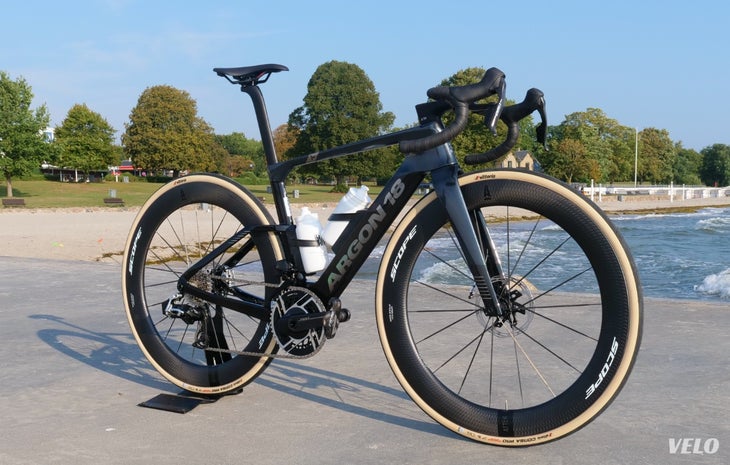 If only I had deep pockets!
If only I had deep pockets!
First Ride
Now, as always, please keep in mind that this is a first ride review, a taster of what this bike is. With only 75km of riding on it on some lovely Danish roads and with (believe it or not) two outiders on motorbikes stopping traffic and allowing us to run red lights safely, it’s a soupçon worth of a ride, albeit a lovely and safe ride that gives me an idea of the Nitrogen’s performance. But saying this, it’s become a bike that has more than piqued my interest, a bike that falls into the camp of few bikes where I’d actually chase up the opportunity to put some miles on it seriously.
So yes, the new Nitrogen is a lovely bike; it offers a lot for admittedly a lot of money, but for better or worse (definitely worse), all top-end bikes are expensive today. And yes, it’s in that superbike territory, a place that is getting crowded, and you could argue that it is the higher echelon of that bracket, roughly $ 1,000-$ 1,500 more than your “standard” race bike with the same components. But I would think that if you have $11,000 to spend on a bike, you’re not going to be hard-pressed or worry too much about finding that extra $1,500, I’m guessing. Then again, what do I know? I certainly don’t fall into that camp.
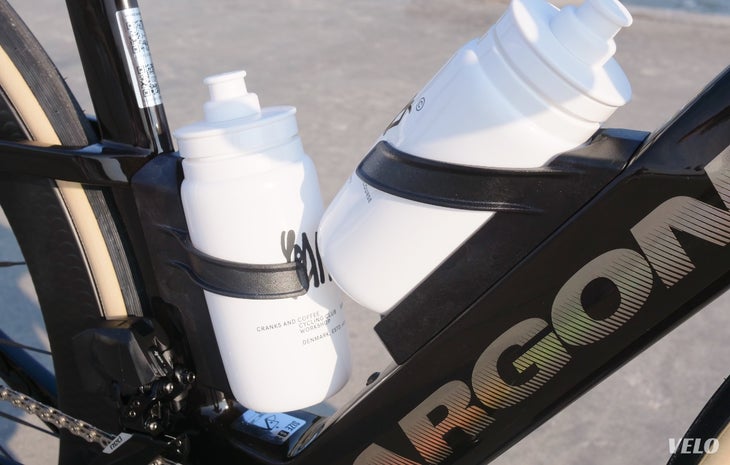 The weight even includes the integrated cages.
The weight even includes the integrated cages.
I’m not the sort of rider who lusts after aero bikes; they usually don’t float my boat. Perhaps it’s because, over the past two years, I’ve noticed they have become more extreme in design, and dare I say, some of the resulting machines are pretty ugly. They’ll also be the fact that I live in a hilly area, and don’t go fast enough to warrant the extra whoosh of a dedicated aero bike. But the Nitrogen has a heap of character and low weight that I can get behind, and get excited about.
If you want a quick roundup, here it is: it’s rapid, light, and comfortable for an aero bike, especially when compared to some aero bikes that seem to have overlooked this character of bike design. All-day comfort shouldn’t be an issue on the Nitrogen. The engineers at Argon 18 have produced a bike that is more than just aero-focused, but feels closer to an all-around, everyday race bike, yet feels lightning fast when you get the power down and give it some juice.
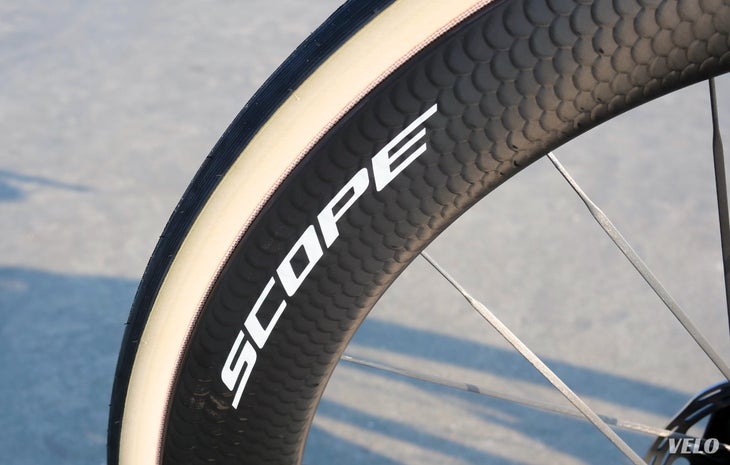 Don’t expect to be able to hear yourself over the Scope hub; it’s loud.
Don’t expect to be able to hear yourself over the Scope hub; it’s loud.
Ok, so let’s delve into the fine points.
Rapid, yes. We can tick that one off the to-do list for this bike. They’ve achieved it without worry, and as well they should, what with a vast knowledge of producing track bikes. You put the hammer down, and it goes and holds that speed. Its power transfer is up there with the best. But what makes it stand out in the aero category is the fact that it feels fast, at any speed, which can’t be said for other aero bikes. I attribute this to the lightweight (which I’ll get to in a moment) and what feels like a shorter wheelbase (for an aero bike). It has a constant nippy feeling to it. Rolling along at a sedate pace doesn’t have the Nitrogen feeling like a battleship underneath you. It’s a lively ride.
Comfort-wise, it’s more than adequate; it’s a race bike after all, so it needs that stiffness, and no matter how many brands say that they can have comfort and stiffness in one package, I’ve yet to find that perfect elusive balance. But saying that, this is a bike you can most definitely go and do big miles on, some aero race bikes I’ve tested don’t offer that: sacrificing stiffness and power transfer for any hint of all-day comfort.
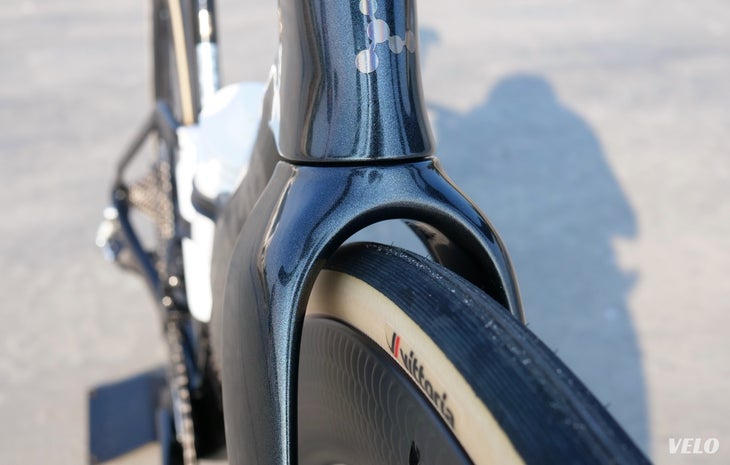 No bags of clearance, but enough for 32mm tires and the 30mm that they say work best with the Nitrogen.
No bags of clearance, but enough for 32mm tires and the 30mm that they say work best with the Nitrogen.
And as for that other factor everyone looks for in a race bike, weight, or lightness, well, yes, you can tick that off too. Or at least in the build I rode. At under 7kg for a fully built medium frame, with bottle cages, it’s a bike I’d love to test on some climbs. Obviously, something that wasn’t possible on our test ride in and around Copenhagen, Denmark. Even so, you can feel the lack of weight in the bike at all times.
One thing that I did get to test this bike out in, though, was crosswind action.
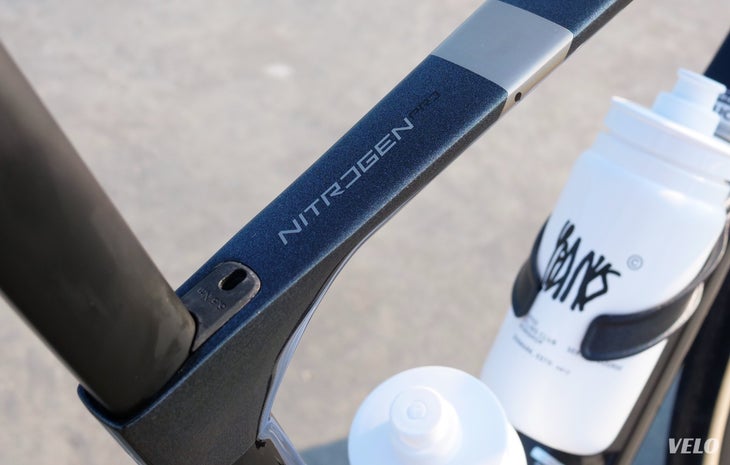 The finish and details are also impressive.
The finish and details are also impressive.
The deep tubing, deep wheels, light weight and a very windy day on the coast of Denmark should have had me thrown all over the place. But to my surprise, the bike handles exceptionally well in crosswinds. I found it a very stable bike. Which was even more of a surprise as I was using the 360mm Attn bars that come as standard. Now, I’m no fan of narrow bars; I’m of that age where they still feel like a trend rather than the gain they are, but the one-piece Attn bars took me all of about 15 minutes of riding to get used to. The depth of the drop was relatively traditional, the width obviously not, and the flair is very welcome and well thought out. Cramped, it is not. I know bars are a personal thing, but for me, it feels like they’ve really done their homework in this area, and that includes the slight angle of the top, which is done for aero gains but also helps with wrist tilt (if that’s a thing).
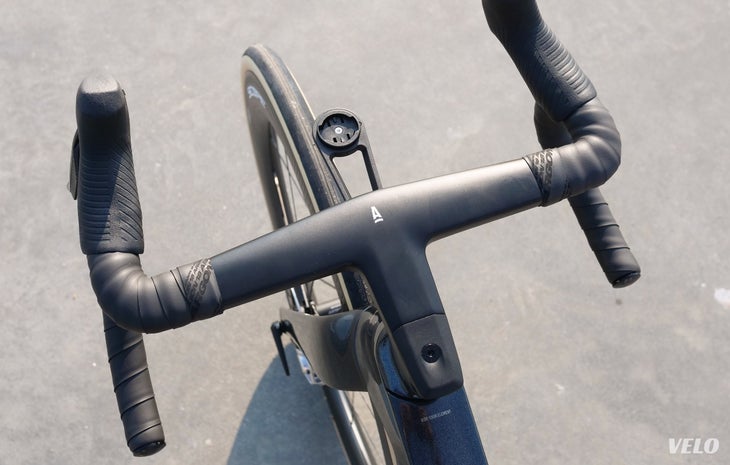 The slight backwards lean of the bar helps with wrist position.
The slight backwards lean of the bar helps with wrist position.
As you can see, it’s a bike I thoroughly enjoyed using. So what’s wrong with it? What are the negatives? With only 75km on it, it’s hard to really pinpoint any from the short time I’ve had on it. Maybe if you’re not a fan of Vittoria Corsa tires in 30mm, and because the engineers at Argon 18 have designed the wheels around that tire, you’ll see that as negative, I personally love the suppleness and grip of a Corsa. The price will most definitely be a negative too for most, but there are less expensive builds. And I have already requested a low-end build for review. I want to see if the bike still lives up to my initial impression, even with mid-range components and the heavier Elite carbon lay-up.
I’ve also not had the opportunity to see how serviceable the bike is, as we all know, these integrated cockpits can be a slog to work on at times.
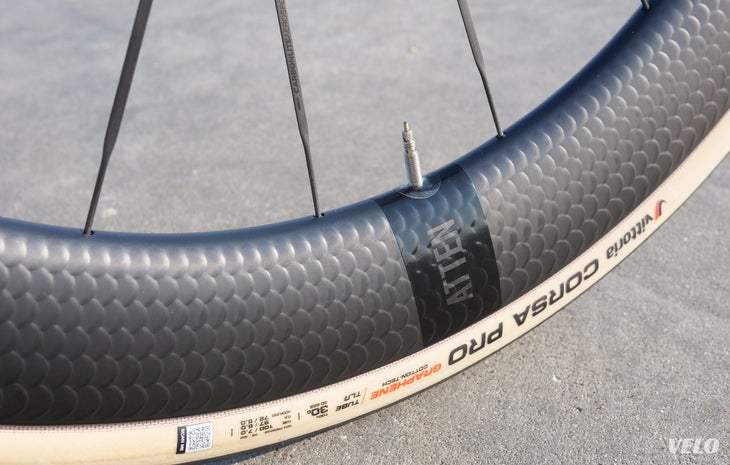 If you don’t like the Vittoria Corsa tires in 30mm that may be one of the only downsides of this bike.
If you don’t like the Vittoria Corsa tires in 30mm that may be one of the only downsides of this bike.
And lastly, Argon 18 doesn’t have that “cultural cachet” for many. But does that matter? I don’t think so, but the “cool kids” may. Is it a brand that’ll wow them at the coffee shop? It’s something that some may take into account, but certainly shouldn’t.
All in all, I thoroughly enjoyed my time on the bike; it’s an impressive machine, and the two years that they have been working on it have not resulted in a half-baked, cutty cutter aero bike. It sits above many race bikes I’ve had the opportunity to throw a leg over in the past few years, and not just aero bikes, but all-around race bikes. Ones that have had the aero aspects toned down to allow for better riding characteristics to shine, the Argon 18 Nitrogen seems to offer it all. The Danish/Canadian company is on to a good thing.

